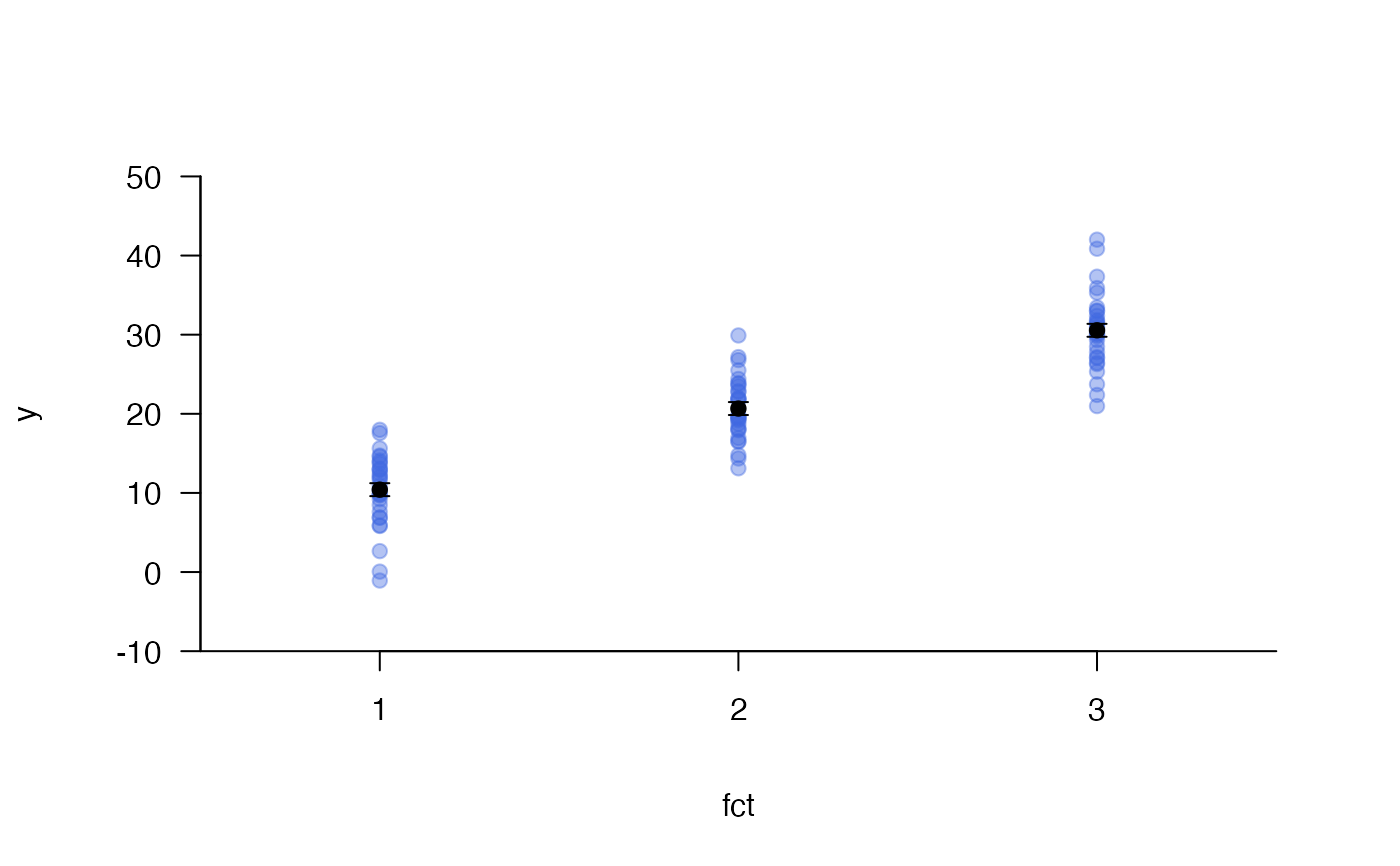This function is used to add error bars (and fitted values) to a plot. Fitted values are marked as points (if requested) around which error bars are drawn (horizontally or vertically as appropriate). Error bars can be specified via the values of the explanatory variable (x), the fitted values (fit) and (a) their standard errors (which are multiplied by a user-defined scale parameter to define the limits of each error bar) or (b) the lower and upper values of each error bar (lwr and upr) directly.
add_error_bars( x, fit, se = stats::sd(fit), scale = 1, lwr = fit - scale * se, upr = fit + scale * se, length = 0.05, horiz = FALSE, add_fit = list(pch = 21, bg = "black"), add_fitted = NULL, ... )
Arguments
| x | The values of an explanatory variable at which the error bars will be placed (e.g. factor levels). |
|---|---|
| fit | The fitted values from a model, around which error bars will be drawn. |
| se, scale | A number or vector of numbers that define(s) the standard error(s) ( |
| lwr, upr | A vector of numbers, of the same length as |
| length | A numeric value which defines the length of the horizontal tips of the error bars. |
| horiz | A logical value that defines whether or not error bars will be drawn vertically ( |
| add_fit | A named list of graphical parameters, passed to |
| add_fitted | (depreciated) See |
| ... | Other arguments passed to |
See also
This function is designed for discrete explanatory variables. add_error_envelope is used for continuous explanatory variables to add regression lines and associated error envelopes to plots.
Author
Edward Lavender
Examples
#### Example dataframe # Define a hypothetical dataframe with predictor values and fitted values sim <- data.frame(type = factor(LETTERS[1:3]), fit = c(20, 30, 40)) #### Example (1): Vertical error bars ## Vertical error bars based on SE # Visualise vertical error bars based on (hypothetical) SE pretty_plot(sim$type, sim$fit, type = "n", ylim = c(0, 50))#>add_error_bars(sim$type, sim$fit, se = 5, lwd = 3)#># Adjust SE before implementing the function to show CIs pretty_plot(sim$type, sim$fit, type = "n", ylim = c(0, 50))#>add_error_bars(sim$type, sim$fit, se = 5*1.96)#># Or simply adjust the arument to 'scale' pretty_plot(sim$type, sim$fit, type = "n", ylim = c(0, 50))#>add_error_bars(sim$type, sim$fit, se = 5*1.96)#>## Vertical error bars based on lwr and upper estimates sim$lwr <- c(10, 5, 35) sim$upr <- c(30, 40, 45) pretty_plot(sim$type, sim$fit, type = "n", ylim = c(0, 50))#>add_error_bars(sim$type, sim$fit, lwr = sim$lwr, upr = sim$upr)#>#### Example (2): Horizontal error bars ## Horizontal error bars (via horiz = TRUE) based on SEs pretty_plot(sim$fit, sim$type, type = "n", xlim = c(0, 50))#>add_error_bars(sim$type, sim$fit, se = 5, horiz = TRUE)#>## Horizontal error bars (via horiz = TRUE) based on lwr and upr estimates pretty_plot(sim$fit, sim$type, type = "n", xlim = c(0, 50))#>add_error_bars(sim$type, sim$fit, lwr = sim$lwr, upr = sim$upr, horiz = TRUE)#>#### Example (3) Customise error bars by supplying additional arguments via ... # ... that are passed to graphics::arrows() pretty_plot(sim$type, sim$fit)#>add_error_bars(x = sim$type, fit = sim$fit, se = 5, length = 0.25, col = "red", lwd = 2)#>#### Example (4): Add the fitted points on by passing a list to the add_fit argument: pp <- par(mfrow = c(1, 2)) # Example with customised points: pretty_plot(sim$type, sim$fit)#>add_error_bars(x = sim$type, fit = sim$fit, se = 5, lwd = 2, add_fit = list(pch = 21, bg = "black"))#>#>#>par(pp) #### Example (5): More realistic example using model derived estimates ## Simulate data # Imagine a scenario where we have n observations for j factor levels # Successive factor levels have expected values that differ by 10 units # The observed response is normally distributed around expected values with some sd ## Simulate data set.seed(1) n <- 30; j <- 3 fct <- sort(factor(rep(1:j, n))) # Define means for each factor level mean_vec <- seq(10, by = 10, length.out = j) # Define expected values for each fct mu <- stats::model.matrix(~fct - 1) %*% mean_vec # Define simulated observations sd <- 5 y <- stats::rnorm(length(mu), mu, sd) ## Use a model to extract fitted values/coefficients # Model data, using a means parameterisation for convenience fit <- stats::lm(y ~ fct - 1) # Extract fitted values and coefficients coef <- summary(fit)$coefficients fit <- coef[, 1]; fit#> fct1 fct2 fct3 #> 10.41229 20.66387 30.55139se <- coef[, 2]; se#> fct1 fct2 fct3 #> 0.8179924 0.8179924 0.8179924## Add error bars using the default options: pch_col <- scales::alpha("royalblue", 0.4) pretty_plot(fct, y, pch = 21, col = pch_col, bg = pch_col)#>add_error_bars(x = 1:3, fit = fit, se = se)








